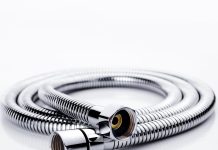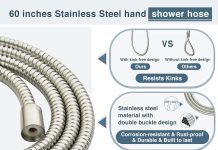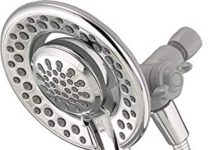Having a functional and reliable shower hose is essential for a refreshing and enjoyable showering experience. However, many people overlook the importance of proper maintenance for their shower hose. In this article, we will explore the essential steps and tips to keep your shower hose in excellent working condition, ensuring long-lasting durability and optimal performance. From regular cleaning to checking for leaks, we’ve got you covered with all the necessary maintenance tasks to keep your shower hose in top shape. So let’s dive in and learn how to care for your shower hose!
Table of Contents
1. Cleaning
Keeping the shower hose clean is an important part of its maintenance. Over time, debris can accumulate in the hose, which can affect its performance and lead to blockages. To ensure a clean and efficient shower hose, there are several cleaning methods that we can employ.
1.1 Removing debris
The first step in cleaning a shower hose is to remove any debris that may have accumulated inside. Debris such as hair, soap scum, and mineral deposits can hinder water flow and cause blockages. To remove these particles, we can gently detach the hose from the showerhead and faucet and then flush it out with water. Holding one end of the hose over a bucket or sink, we can run water through it to dislodge any debris. By doing this, we ensure that the hose is free from any obstructions and can function optimally.
1.2 Cleaning with vinegar
Vinegar is a versatile household cleaner that can be used effectively to clean a shower hose. Its acidic nature helps dissolve mineral deposits, limescale, and soap scum, leaving the hose clean and free-flowing. To clean the hose with vinegar, we can fill a basin or sink with equal parts vinegar and warm water. Then, we can immerse the hose in the solution and let it soak for about 30 minutes. After soaking, we can rinse the hose thoroughly with water to remove any vinegar residue. This simple cleaning method can help improve the longevity and performance of the shower hose.
1.3 Using a pipe cleaner
For stubborn debris or hard-to-reach areas of the shower hose, using a pipe cleaner can be an effective solution. A pipe cleaner is a flexible wire brush that can be inserted into the hose to remove accumulated grime and dirt. By gently maneuvering the pipe cleaner through the hose, we can dislodge any obstructions and ensure a clean and clear path for water flow. After using the pipe cleaner, it is important to rinse the hose thoroughly with water to remove any loosened debris.
2. Checking for Leaks
One of the most common issues with shower hoses is leaks. Even a small leak can lead to water wastage and increased utility bills. Therefore, it is important to regularly check for leaks and address them promptly.
2.1 Inspecting for visible leaks
The first step in checking for leaks is to visually inspect the hose for any signs of water leakage. By running our hand along the hose while the water is turned on, we can feel for any wet spots or drips. Additionally, we can also examine the hose for cracks, splits, or worn-out areas that may be causing the leakage. If any visible leaks or damages are found, it is advisable to replace the hose or repair it to prevent further issues.
2.2 Listening for water drips
In some cases, leaks may not be immediately visible, especially if they are occurring within the walls of the hose. To detect such hidden leaks, we can listen for any water drips or hissing sounds. By turning off all other sources of water in the vicinity and listening closely to the shower hose, we can identify any abnormal sounds that may indicate a leak. If any leaks are detected through this method, it is essential to address them promptly to prevent water damage and wastage.
2.3 Using soapy water test
Another effective method to check for leaks is the soapy water test. This simple technique involves creating a mixture of soapy water and applying it to the hose while the water is turned on. If there are any leaks, the pressure of the water will cause bubbles to form at the site of the leakage, making it easy to identify. By conducting this test along the entire length of the hose, we can identify any leaks and take appropriate measures to fix them. Fixing leaks promptly not only saves water but also ensures the optimal functioning of the shower hose.
This image is property of i.ytimg.com.
3. Examining Hose Fittings
The fittings of the shower hose play a crucial role in its performance and durability. Regular examination of the hose fittings is necessary to ensure their tightness and identify any damages that may require attention.
3.1 Checking tightness
Checking the tightness of the hose fittings is a simple yet important task in maintaining the shower hose. Over time, fittings may become loose due to repeated use or water pressure. By using our hands or a wrench, we can ensure that the fittings are securely tightened without being overly tightened, which can cause damage. This regular check ensures that the fittings remain in place and prevent any potential leaks.
3.2 Inspecting for damage
Apart from checking the tightness, it is equally crucial to inspect the hose fittings for any damages. Damaged fittings, such as cracks or dents, can lead to leaks or reduced water flow. By visually examining the fittings, we can identify any signs of damage and take the necessary steps to repair or replace them. Regular inspections can prevent potential issues and extend the lifespan of the shower hose.
3.3 Replacing worn fittings
In some cases, hose fittings may become worn out or damaged beyond repair. If this is the case, it is advisable to replace the fittings promptly to prevent any further damage or leaks. When purchasing replacement fittings, it is important to ensure that they are compatible with the shower hose. Following the manufacturer’s instructions, we can carefully remove the old fittings and install the new ones, ensuring a secure and leak-free connection.
4. Preventing Kinks
Kinks in a shower hose can restrict water flow and cause unnecessary strain on the hose itself. Therefore, it is essential to take preventive measures to avoid kinks and maintain the longevity of the hose.
4.1 Avoiding tight bends
One of the primary causes of hose kinks is tight bends or sharp angles. When installing or repositioning the shower hose, it is important to avoid creating tight bends that can lead to kinking. By keeping the hose as straight as possible and minimizing unnecessary twists and turns, we can prevent kinks and ensure smooth water flow.
4.2 Using a hose guide
To further prevent kinks, we can use a hose guide. A hose guide is a device or accessory that helps guide the hose around corners or obstacles without creating tight bends. By following the path suggested by the hose guide, we can ensure that the hose remains straight and kink-free. These guides are available in various designs, including wall-mounted guides and guides attached to the shower wall, providing flexibility and ease of use.
4.3 Replacing a kinked hose
If a hose becomes kinked despite preventive measures, it is important to address the issue promptly. Kinks can restrict water flow and eventually lead to leaks or damages to the hose. If the kink is minor, we can attempt to manually straighten the hose by carefully bending it in the opposite direction of the kink. However, if the kink is severe or persists, it is advisable to replace the hose entirely to ensure optimal performance and prevent future kinks.
This image is property of assets.hansgrohe.com.
5. Removing Limescale Buildup
Limescale buildup is a common issue in areas with hard water, and it can affect the performance of the shower hose. By regularly removing limescale buildup, we can ensure a smooth and uninterrupted water flow.
5.1 Using a limescale remover
A limescale remover is an effective solution for removing stubborn limescale deposits from the shower hose. These products are readily available in supermarkets and hardware stores. Following the instructions on the packaging, we can apply the limescale remover to the affected areas of the hose and let it sit for the recommended duration. Then, using a soft cloth or sponge, we can gently scrub the hose to remove the loosened limescale. Finally, we should thoroughly rinse the hose with water to remove any residue from the limescale remover.
5.2 Soaking in vinegar solution
Vinegar is a natural and cost-effective alternative to commercial limescale removers. By creating a vinegar solution with equal parts vinegar and water, we can immerse the shower hose in the solution and let it soak for a few hours. The acidic properties of vinegar help dissolve the limescale buildup, making it easier to remove. After soaking, we can rinse the hose thoroughly with water to ensure that all traces of vinegar and dissolved limescale are removed.
5.3 Scrubbing with a toothbrush
For smaller or localized limescale deposits, using a toothbrush can be an effective method of removal. By dampening a toothbrush with vinegar or limescale remover, we can gently scrub the affected areas of the hose in a circular motion. The bristles of the toothbrush help dislodge the limescale buildup, allowing it to be rinsed away easily. After scrubbing, we should rinse the hose with water to remove any residue from the cleaning solution and limescale.
6. Inspecting for Mold or Mildew
Mold or mildew growth on the shower hose not only affects its appearance but can also lead to health concerns. Regular inspection and cleaning are necessary to prevent mold or mildew from taking hold.
6.1 Checking hose surface
Regularly checking the surface of the shower hose for any signs of mold or mildew is crucial in preventing their growth. Mold and mildew thrive in humid and damp environments, making the shower hose an ideal breeding ground. By visually inspecting the hose, we can identify any visible signs of mold or mildew, such as black spots or patches. Additionally, we should also be mindful of any musty odor emanating from the hose, as this can be an indication of mold or mildew growth.
6.2 Cleaning with mold/mildew remover
If mold or mildew is found on the surface of the shower hose, it is important to address the issue promptly to prevent its spread. Using a mold or mildew remover, we can apply the product to the affected areas of the hose and allow it to sit for the recommended duration. The remover works to eliminate the mold or mildew spores, ensuring a clean and hygienic hose. After the recommended duration, we should rinse the hose thoroughly with water to remove any residue from the remover.
6.3 Regularly drying the hose
To prevent the growth of mold or mildew, it is essential to ensure that the shower hose is thoroughly dried after each use. Moisture left inside the hose provides an ideal environment for mold and mildew spores to thrive. By carefully shaking out any excess water from the hose and allowing it to air dry, we can eliminate the moisture and reduce the risk of mold or mildew growth. Additionally, we can also consider wiping the surface of the hose with a dry cloth to further aid in the drying process.
This image is property of blogger.googleusercontent.com.
7. Lubricating Hose Connections
To maintain the ease of use and prevent wear and tear on the hose connections, lubrication is key. Regularly lubricating the hose connections ensures smooth operation and prevents unnecessary strain on the hose.
7.1 Applying plumber’s grease
Plumber’s grease is a silicone-based lubricant that is specifically designed for plumbing applications. Applying a small amount of plumber’s grease to the hose connections helps reduce friction and eases the movement of the fittings. By simply applying a thin layer of grease to the threads of the connections, we can ensure smooth screwing and unscrewing of the fittings, preventing any strain on the hose. However, it is important not to overapply the grease, as excess grease can attract dirt and debris.
7.2 Using silicone lubricant
Silicone lubricant is another suitable lubricant for shower hose connections. Similar to plumber’s grease, silicone lubricant reduces friction, making it easier to tighten or loosen the fittings without putting unnecessary stress on the hose. To apply silicone lubricant, we can simply spray a small amount onto a cloth or directly onto the fittings, ensuring even coverage. By lubricating the hose connections, we can maintain their longevity and ensure a secure and leak-free connection.
7.3 Tightening loose connections
Tightening loose connections is an important step in maintaining the shower hose and preventing leaks. Over time, fittings may become loose due to repeated use or the natural shifting of the hose. By regularly checking the tightness of the connections and tightening any loose fittings, we can prevent leaks and ensure a secure connection. Using our hands or a wrench, we should ensure that the fittings are securely tightened without over-tightening, which can cause damage to the hose or fittings.
8. Protecting Hose from Extreme Temperatures
Extreme temperatures can have adverse effects on the shower hose, leading to damage and reduced longevity. By taking preventive measures, we can protect the hose from extreme temperatures and maintain its optimal performance.
8.1 Insulating hose in cold conditions
During cold weather, it is important to protect the shower hose from freezing temperatures. Freezing water inside the hose can cause it to expand and potentially burst, leading to leaks and damages. To prevent this, we can insulate the hose by wrapping it with pipe insulation or covering it with foam sleeves. These insulation methods help to maintain the temperature of the water inside the hose and protect it from freezing.
8.2 Avoiding exposure to direct sunlight
Excessive exposure to direct sunlight can also cause damage to the shower hose. Sunlight can degrade the materials of the hose, leading to cracks, discoloration, and reduced flexibility. To protect the hose from sunlight, we should ensure that it is not exposed to prolonged periods of direct sunlight. If the hose is installed outdoors, we can consider using a shade or covering it with a hose reel or container to shield it from the sun’s rays.
8.3 Using a shower hose cover
For additional protection from extreme temperatures and sunlight, we can invest in a shower hose cover. A shower hose cover is a protective sleeve that wraps around the hose, providing insulation and shielding it from the elements. These covers are available in different materials, such as neoprene or fabric, and are easy to install. By using a shower hose cover, we can prolong the lifespan of the hose and maintain its functionality under various weather conditions.
This image is property of www.chinashowerhose.com.
9. Regularly Checking Hose Length
Regularly checking the length of the shower hose is essential in maintaining its proper extension and ensuring an optimal shower experience.
9.1 Ensuring proper extension
It is important to ensure that the shower hose is extending to its full length without any restrictions. Over time, the hose may become twisted, tangled, or shortened due to repeated use or improper storage. By carefully stretching out the hose to its maximum length, we can check for any kinks, twists, or restrictions that may be hindering its extension. If any issues are found, we can manually straighten the hose or employ the use of a hose guide to ensure proper extension.
9.2 Replacing a worn-out hose
If the shower hose has become too short or has suffered significant wear and tear, it may be necessary to replace it entirely. Signs of a worn-out hose include cracks, splits, or dents that may affect its functionality or lead to leaks. When replacing the hose, it is important to choose a suitable replacement that is compatible with the showerhead and the plumbing system. Following the manufacturer’s instructions, we can carefully remove the old hose and install the new one, ensuring a secure and leak-free connection.
10. Proper Storage
Proper storage of the shower hose is crucial in maintaining its longevity and preventing unnecessary damage. By following a few simple storage practices, we can ensure that the hose remains in optimal condition.
10.1 Keeping the hose dry
Before storing the shower hose, it is important to ensure that it is thoroughly dry. Moisture left inside the hose can create an environment for mold or mildew growth or lead to the development of limescale deposits. By carefully shaking out any excess water and allowing the hose to air dry, we can eliminate moisture and prevent these issues. Additionally, we can consider wiping the surface of the hose with a dry cloth to speed up the drying process.
10.2 Finding a suitable storage location
When it comes to storing the shower hose, it is important to find a suitable location that protects it from potential damage. Ideally, the hose should be stored indoors or in a covered area away from extreme temperatures, direct sunlight, and moisture. Additionally, we should ensure that the hose is not exposed to any sharp objects or heavy items that can cause physical damage. By finding a suitable storage location, we can prolong the lifespan of the hose and maintain its functionality.
10.3 Avoiding tangling
Tangling of the shower hose can lead to kinks and damage that affect its water flow and overall performance. To avoid tangling, we can employ various storage methods. One effective method is coiling the hose loosely and securing it with a hose reel or hanger. By coiling the hose with larger loops, we can prevent tangling and minimize strain on the hose. Additionally, using a hose reel or hanger keeps the hose neatly organized and easily accessible for future use.
In conclusion, maintaining a shower hose requires regular cleaning, checking for leaks, examining hose fittings, preventing kinks, removing limescale buildup, inspecting for mold or mildew, lubricating hose connections, protecting from extreme temperatures, regularly checking hose length, and proper storage. By following these maintenance practices, we can ensure a clean, efficient, and long-lasting shower hose that provides an optimal showering experience.
This image is property of assets.hansgrohe.com.



























